2010 FORD SUPER DUTY oil filter
[x] Cancel search: oil filterPage 5 of 104
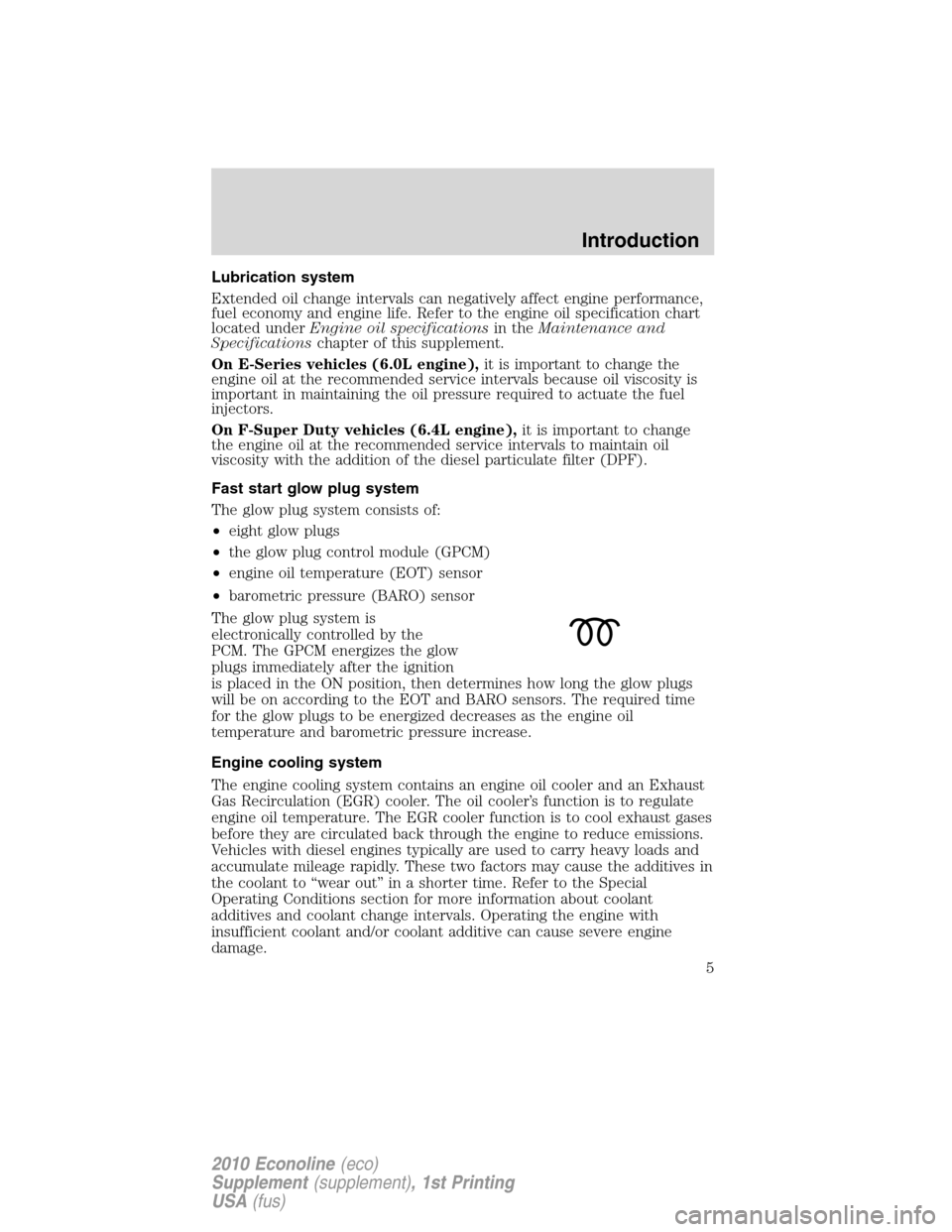
Lubrication system
Extended oil change intervals can negatively affect engine performance,
fuel economy and engine life. Refer to the engine oil specification chart
located underEngine oil specificationsin theMaintenance and
Specificationschapter of this supplement.
On E-Series vehicles (6.0L engine),it is important to change the
engine oil at the recommended service intervals because oil viscosity is
important in maintaining the oil pressure required to actuate the fuel
injectors.
On F-Super Duty vehicles (6.4L engine),it is important to change
the engine oil at the recommended service intervals to maintain oil
viscosity with the addition of the diesel particulate filter (DPF).
Fast start glow plug system
The glow plug system consists of:
•eight glow plugs
•the glow plug control module (GPCM)
•engine oil temperature (EOT) sensor
•barometric pressure (BARO) sensor
The glow plug system is
electronically controlled by the
PCM. The GPCM energizes the glow
plugs immediately after the ignition
is placed in the ON position, then determines how long the glow plugs
will be on according to the EOT and BARO sensors. The required time
for the glow plugs to be energized decreases as the engine oil
temperature and barometric pressure increase.
Engine cooling system
The engine cooling system contains an engine oil cooler and an Exhaust
Gas Recirculation (EGR) cooler. The oil cooler’s function is to regulate
engine oil temperature. The EGR cooler function is to cool exhaust gases
before they are circulated back through the engine to reduce emissions.
Vehicles with diesel engines typically are used to carry heavy loads and
accumulate mileage rapidly. These two factors may cause the additives in
the coolant to “wear out” in a shorter time. Refer to the Special
Operating Conditions section for more information about coolant
additives and coolant change intervals. Operating the engine with
insufficient coolant and/or coolant additive can cause severe engine
damage.
Introduction
5
2010 Econoline(eco)
Supplement(supplement), 1st Printing
USA(fus)
Page 12 of 104
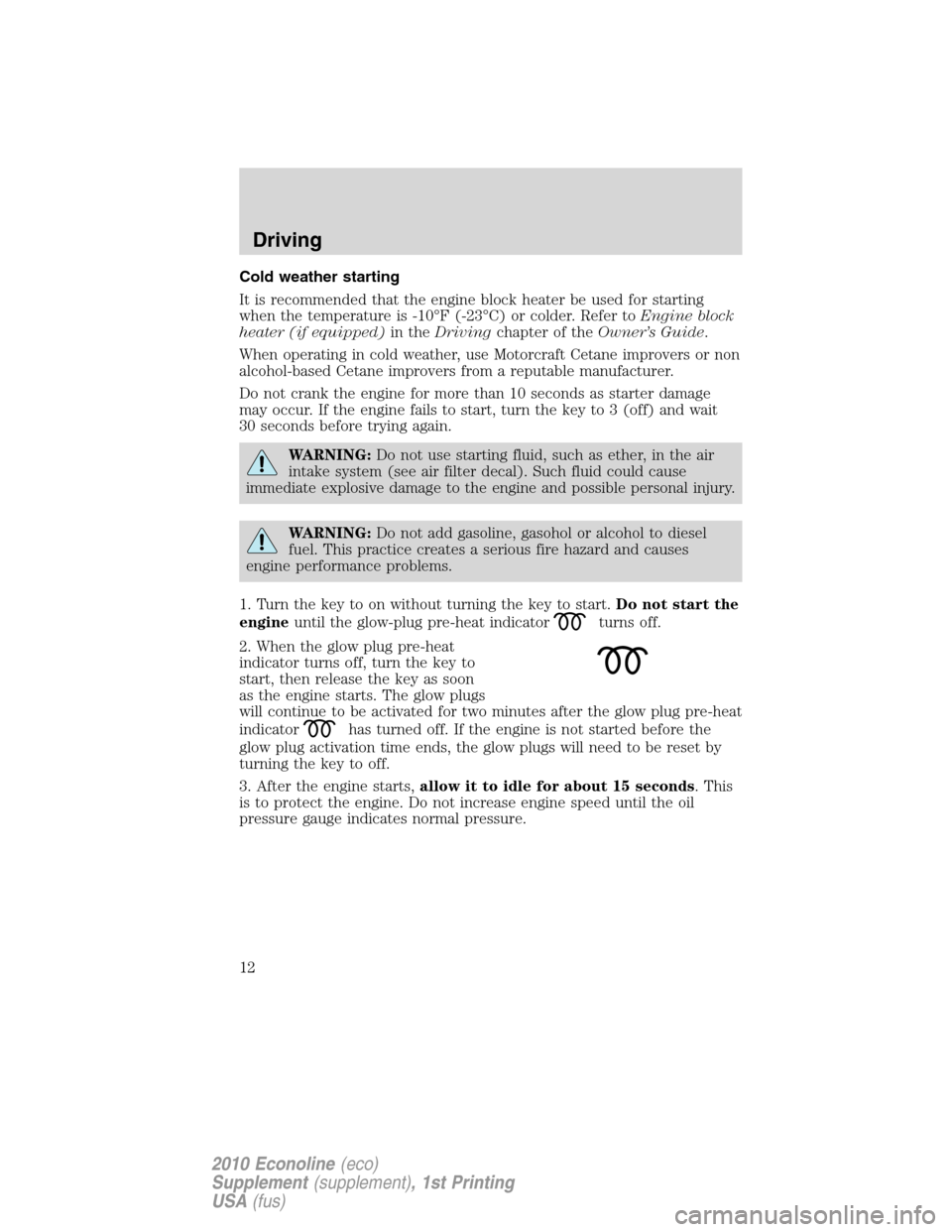
Cold weather starting
It is recommended that the engine block heater be used for starting
when the temperature is -10°F (-23°C) or colder. Refer toEngine block
heater (if equipped)in theDrivingchapter of theOwner’s Guide.
When operating in cold weather, use Motorcraft Cetane improvers or non
alcohol-based Cetane improvers from a reputable manufacturer.
Do not crank the engine for more than 10 seconds as starter damage
may occur. If the engine fails to start, turn the key to 3 (off) and wait
30 seconds before trying again.
WARNING:Do not use starting fluid, such as ether, in the air
intake system (see air filter decal). Such fluid could cause
immediate explosive damage to the engine and possible personal injury.
WARNING:Do not add gasoline, gasohol or alcohol to diesel
fuel. This practice creates a serious fire hazard and causes
engine performance problems.
1. Turn the key to on without turning the key to start.Do not start the
engineuntil the glow-plug pre-heat indicator
turns off.
2. When the glow plug pre-heat
indicator turns off, turn the key to
start, then release the key as soon
as the engine starts. The glow plugs
will continue to be activated for two minutes after the glow plug pre-heat
indicator
has turned off. If the engine is not started before the
glow plug activation time ends, the glow plugs will need to be reset by
turning the key to off.
3. After the engine starts,allow it to idle for about 15 seconds. This
is to protect the engine. Do not increase engine speed until the oil
pressure gauge indicates normal pressure.
Driving
12
2010 Econoline(eco)
Supplement(supplement), 1st Printing
USA(fus)
Page 14 of 104

COLD WEATHER OPERATION
Changing to a lighter grade engine oil also makes starting easier under
these conditions. Refer toEngine oil specificationsin theMaintenance
and Specificationschapter of this supplement.
Diesel fuel is adjusted seasonally for cold temperatures. Diesel fuel which
has not been properly formulated for the ambient conditions may form
wax crystals which can clog the fuel filter. At temperatures below 20°F
(–7°C), if the engine starts, stalls after a short time, and then will not
restart, the fuel filter(s) may be clogged. For best results in cold
weather, use a diesel fuel which has been formulated for the ambient
conditions. If you have been using biodiesel, you may need to use a fuel
with lower biodiesel content, try another brand, or discontinue using
biodiesel.
Your vehicle is equipped with either an FCM or HFCM which recirculates
fuel from the engine to help prevent fuel filter clogging. Your vehicle is
also equipped with a bypass relief valve, located in the fuel tank pick-up
boot, which provides fuel flow to the engine if the fuel pickup should
become plugged. To allow the bypass valve to function and avoid engine
fuel starvation during cold weather operation of 32°F (0°C) or below, it
is recommended that the fuel level in your tank should not be allowed to
drop below
1�4full. This will help prevent air from entering the fuel
system and stalling the engine.
In cold weather below 32°F (0°C), the engine will slowly increase to a
higher idle speed if left idling in P (Park). As the engine warms-up, the
engine sound level will decrease due to the activation of PCM-controlled
sound reduction features.
If your vehicle is operated in a heavy snow storm or blowing snow
conditions, the engine air induction may become partially clogged with
snow and/or ice. If this occurs, the engine may experience a significant
reduction in power output. At the earliest opportunity, clear all the snow
and/or ice away from inside the air filter assembly. Take the top off the
assembly, leaving the air filter in, and remove any snow or ice.
In order to operate the engine in temperatures of 32°F (0°C) or lower,
read the following instructions:
•Make sure that the batteries are of sufficient size and are fully
charged. Check other electrical components to make sure they are in
optimum condition.
•Use Motorcraft Premium Engine Coolant solution at the concentration
recommended to protect the engine against damage from freezing.
•Try to keep the fuel tank full as much as possible at the end of
operation to prevent condensation in the fuel system.
Driving
14
2010 Econoline(eco)
Supplement(supplement), 1st Printing
USA(fus)
Page 15 of 104
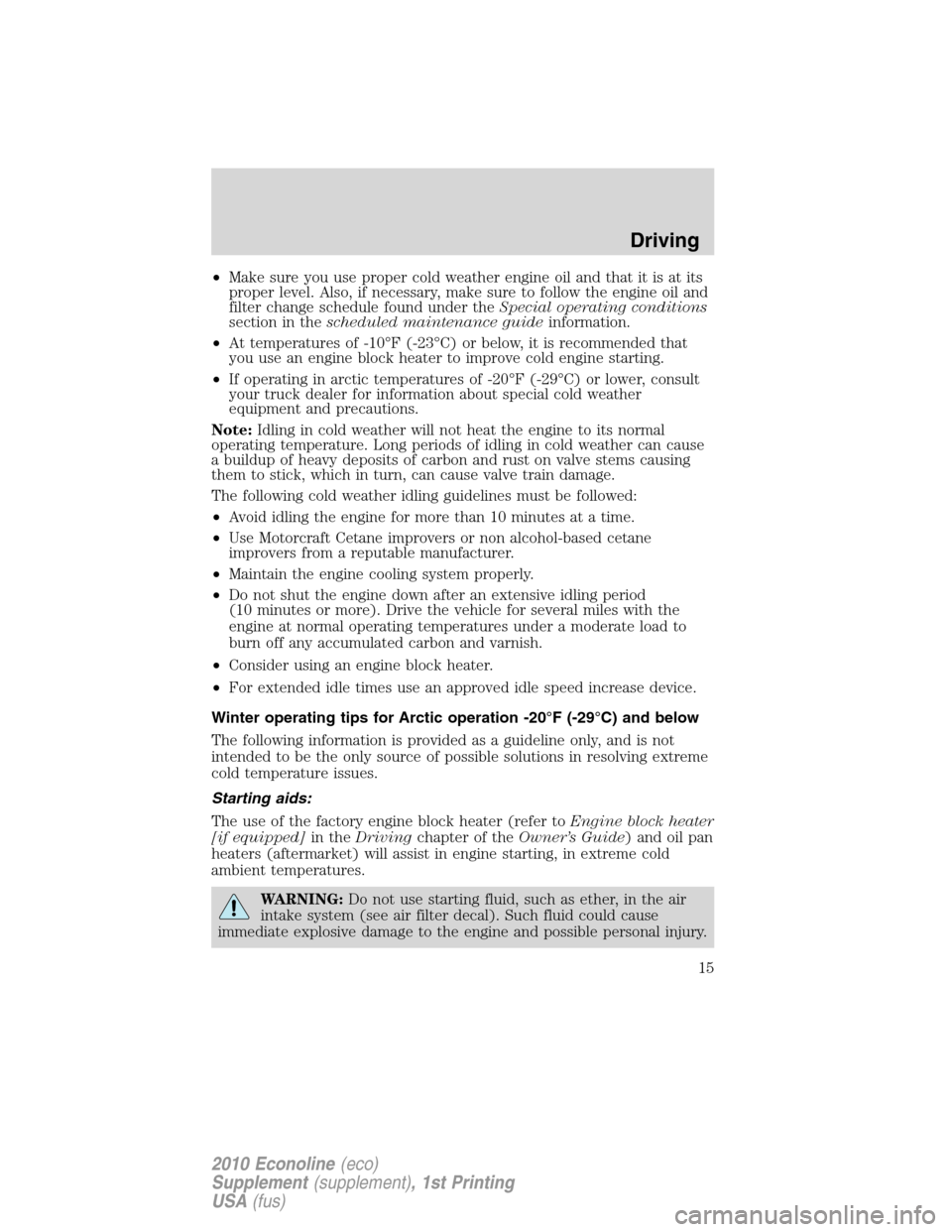
•Make sure you use proper cold weather engine oil and that it is at its
proper level. Also, if necessary, make sure to follow the engine oil and
filter change schedule found under theSpecial operating conditions
section in thescheduled maintenance guideinformation.
•At temperatures of -10°F (-23°C) or below, it is recommended that
you use an engine block heater to improve cold engine starting.
•If operating in arctic temperatures of -20°F (-29°C) or lower, consult
your truck dealer for information about special cold weather
equipment and precautions.
Note:Idling in cold weather will not heat the engine to its normal
operating temperature. Long periods of idling in cold weather can cause
a buildup of heavy deposits of carbon and rust on valve stems causing
them to stick, which in turn, can cause valve train damage.
The following cold weather idling guidelines must be followed:
•Avoid idling the engine for more than 10 minutes at a time.
•Use Motorcraft Cetane improvers or non alcohol-based cetane
improvers from a reputable manufacturer.
•Maintain the engine cooling system properly.
•Do not shut the engine down after an extensive idling period
(10 minutes or more). Drive the vehicle for several miles with the
engine at normal operating temperatures under a moderate load to
burn off any accumulated carbon and varnish.
•Consider using an engine block heater.
•For extended idle times use an approved idle speed increase device.
Winter operating tips for Arctic operation -20°F (-29°C) and below
The following information is provided as a guideline only, and is not
intended to be the only source of possible solutions in resolving extreme
cold temperature issues.
Starting aids:
The use of the factory engine block heater (refer toEngine block heater
[if equipped]in theDrivingchapter of theOwner’s Guide) and oil pan
heaters (aftermarket) will assist in engine starting, in extreme cold
ambient temperatures.
WARNING:Do not use starting fluid, such as ether, in the air
intake system (see air filter decal). Such fluid could cause
immediate explosive damage to the engine and possible personal injury.
Driving
15
2010 Econoline(eco)
Supplement(supplement), 1st Printing
USA(fus)
Page 16 of 104
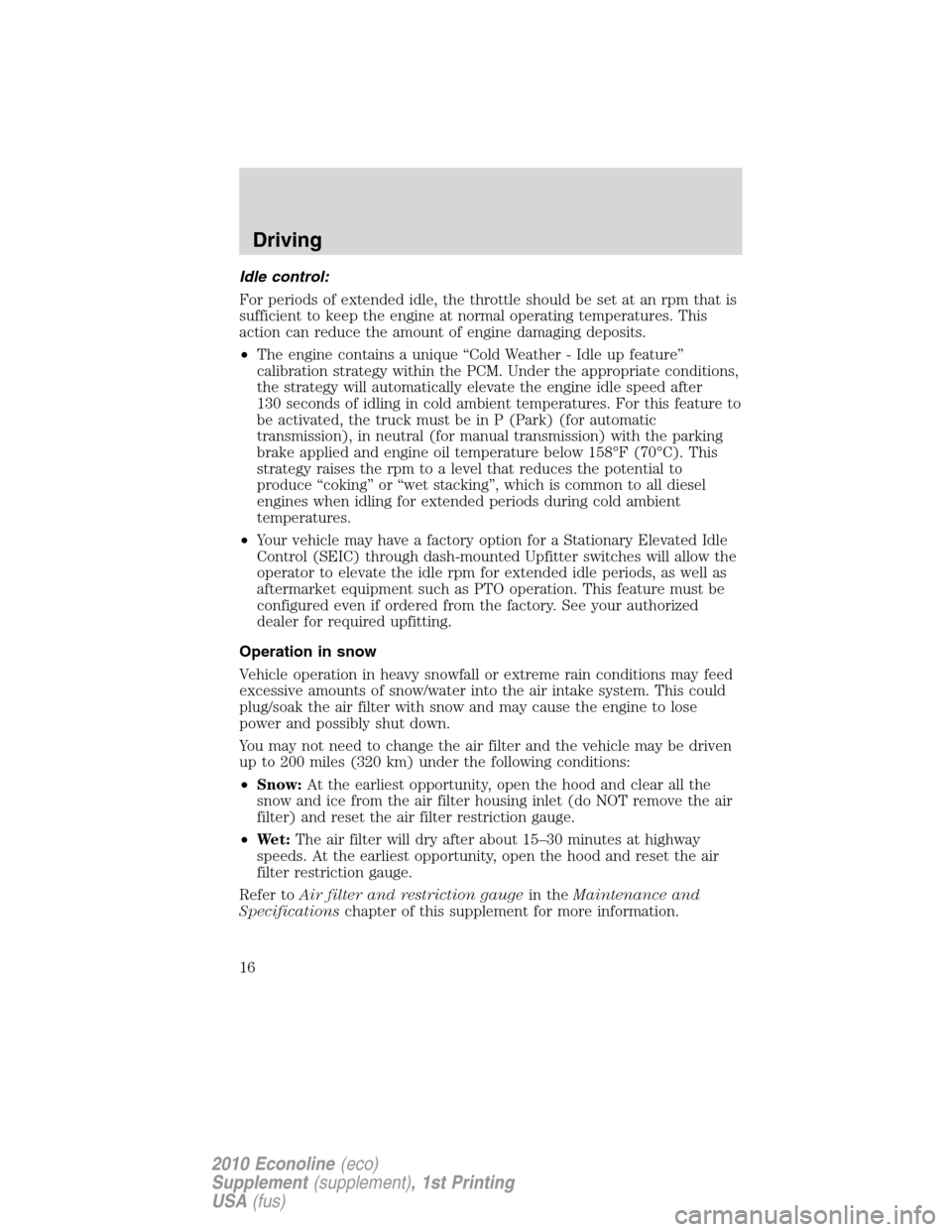
Idle control:
For periods of extended idle, the throttle should be set at an rpm that is
sufficient to keep the engine at normal operating temperatures. This
action can reduce the amount of engine damaging deposits.
•The engine contains a unique “Cold Weather - Idle up feature”
calibration strategy within the PCM. Under the appropriate conditions,
the strategy will automatically elevate the engine idle speed after
130 seconds of idling in cold ambient temperatures. For this feature to
be activated, the truck must be in P (Park) (for automatic
transmission), in neutral (for manual transmission) with the parking
brake applied and engine oil temperature below 158°F (70°C). This
strategy raises the rpm to a level that reduces the potential to
produce “coking” or “wet stacking”, which is common to all diesel
engines when idling for extended periods during cold ambient
temperatures.
•Your vehicle may have a factory option for a Stationary Elevated Idle
Control (SEIC) through dash-mounted Upfitter switches will allow the
operator to elevate the idle rpm for extended idle periods, as well as
aftermarket equipment such as PTO operation. This feature must be
configured even if ordered from the factory. See your authorized
dealer for required upfitting.
Operation in snow
Vehicle operation in heavy snowfall or extreme rain conditions may feed
excessive amounts of snow/water into the air intake system. This could
plug/soak the air filter with snow and may cause the engine to lose
power and possibly shut down.
You may not need to change the air filter and the vehicle may be driven
up to 200 miles (320 km) under the following conditions:
•Snow:At the earliest opportunity, open the hood and clear all the
snow and ice from the air filter housing inlet (do NOT remove the air
filter) and reset the air filter restriction gauge.
•Wet:The air filter will dry after about 15–30 minutes at highway
speeds. At the earliest opportunity, open the hood and reset the air
filter restriction gauge.
Refer toAir filter and restriction gaugein theMaintenance and
Specificationschapter of this supplement for more information.
Driving
16
2010 Econoline(eco)
Supplement(supplement), 1st Printing
USA(fus)
Page 33 of 104
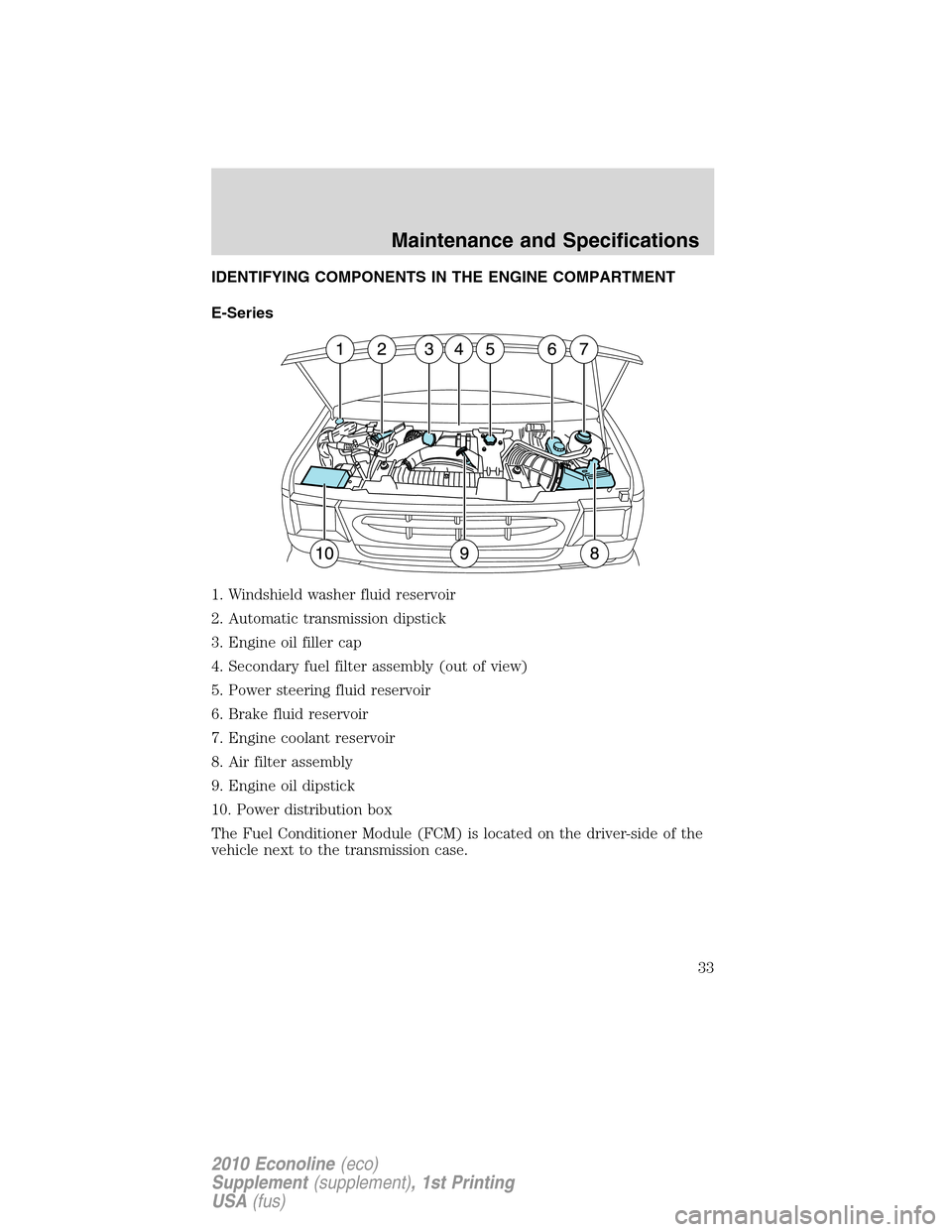
IDENTIFYING COMPONENTS IN THE ENGINE COMPARTMENT
E-Series
1. Windshield washer fluid reservoir
2. Automatic transmission dipstick
3. Engine oil filler cap
4. Secondary fuel filter assembly (out of view)
5. Power steering fluid reservoir
6. Brake fluid reservoir
7. Engine coolant reservoir
8. Air filter assembly
9. Engine oil dipstick
10. Power distribution box
The Fuel Conditioner Module (FCM) is located on the driver-side of the
vehicle next to the transmission case.
Maintenance and Specifications
33
2010 Econoline(eco)
Supplement(supplement), 1st Printing
USA(fus)
Page 34 of 104
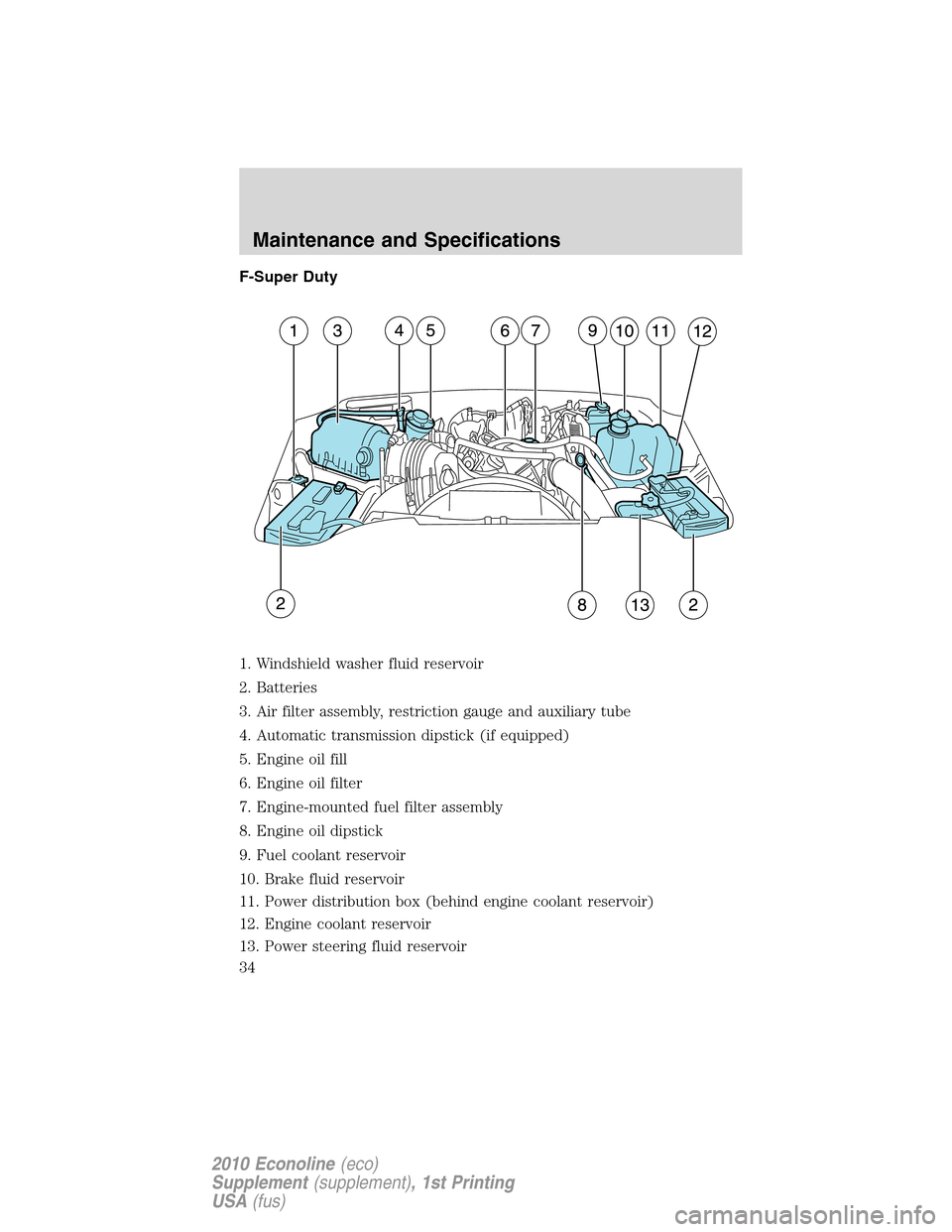
F-Super Duty
1. Windshield washer fluid reservoir
2. Batteries
3. Air filter assembly, restriction gauge and auxiliary tube
4. Automatic transmission dipstick (if equipped)
5. Engine oil fill
6. Engine oil filter
7. Engine-mounted fuel filter assembly
8. Engine oil dipstick
9. Fuel coolant reservoir
10. Brake fluid reservoir
11. Power distribution box (behind engine coolant reservoir)
12. Engine coolant reservoir
13. Power steering fluid reservoir
Maintenance and Specifications
34
2010 Econoline(eco)
Supplement(supplement), 1st Printing
USA(fus)
Page 37 of 104
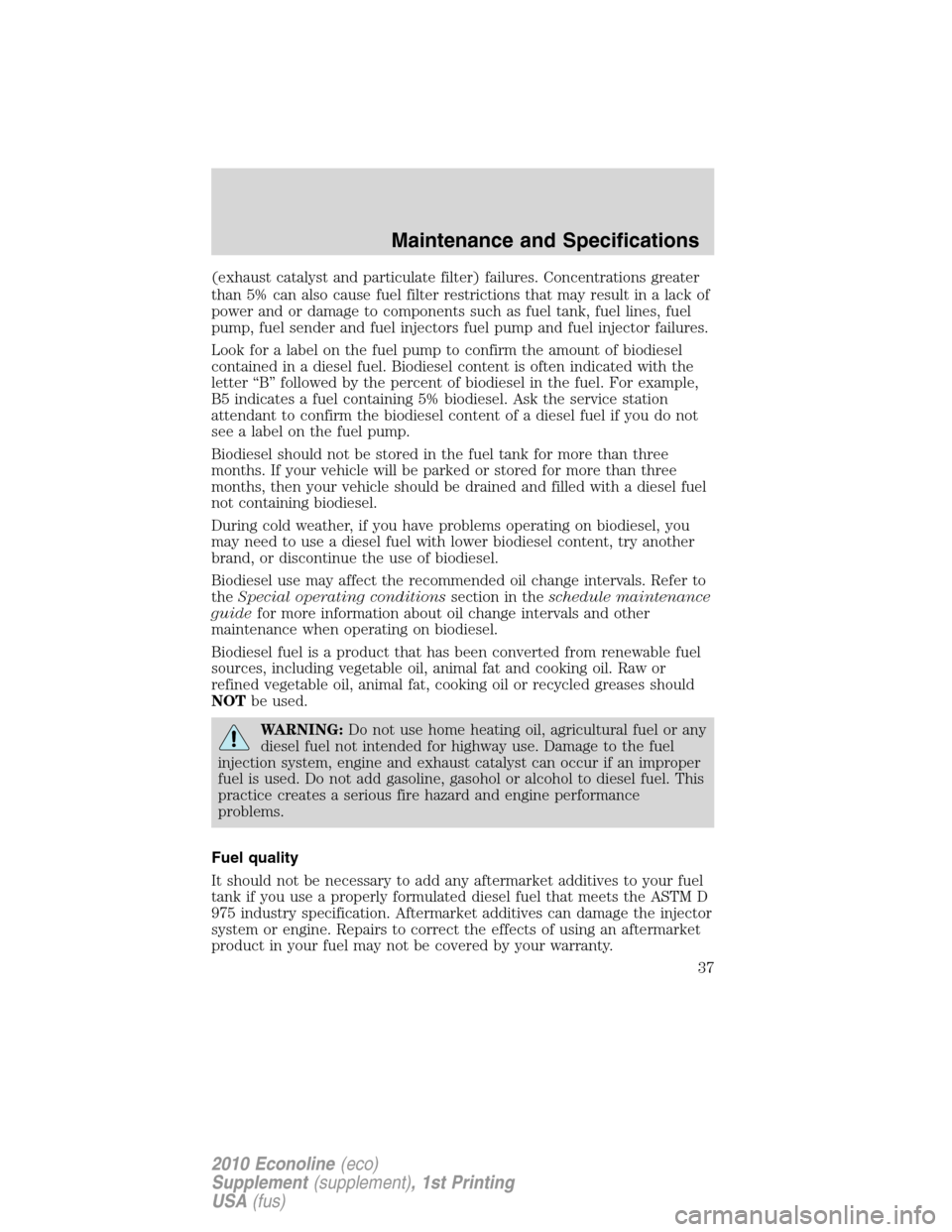
(exhaust catalyst and particulate filter) failures. Concentrations greater
than 5% can also cause fuel filter restrictions that may result in a lack of
power and or damage to components such as fuel tank, fuel lines, fuel
pump, fuel sender and fuel injectors fuel pump and fuel injector failures.
Look for a label on the fuel pump to confirm the amount of biodiesel
contained in a diesel fuel. Biodiesel content is often indicated with the
letter “B” followed by the percent of biodiesel in the fuel. For example,
B5 indicates a fuel containing 5% biodiesel. Ask the service station
attendant to confirm the biodiesel content of a diesel fuel if you do not
see a label on the fuel pump.
Biodiesel should not be stored in the fuel tank for more than three
months. If your vehicle will be parked or stored for more than three
months, then your vehicle should be drained and filled with a diesel fuel
not containing biodiesel.
During cold weather, if you have problems operating on biodiesel, you
may need to use a diesel fuel with lower biodiesel content, try another
brand, or discontinue the use of biodiesel.
Biodiesel use may affect the recommended oil change intervals. Refer to
theSpecial operating conditionssection in theschedule maintenance
guidefor more information about oil change intervals and other
maintenance when operating on biodiesel.
Biodiesel fuel is a product that has been converted from renewable fuel
sources, including vegetable oil, animal fat and cooking oil. Raw or
refined vegetable oil, animal fat, cooking oil or recycled greases should
NOTbe used.
WARNING:Do not use home heating oil, agricultural fuel or any
diesel fuel not intended for highway use. Damage to the fuel
injection system, engine and exhaust catalyst can occur if an improper
fuel is used. Do not add gasoline, gasohol or alcohol to diesel fuel. This
practice creates a serious fire hazard and engine performance
problems.
Fuel quality
It should not be necessary to add any aftermarket additives to your fuel
tank if you use a properly formulated diesel fuel that meets the ASTM D
975 industry specification. Aftermarket additives can damage the injector
system or engine. Repairs to correct the effects of using an aftermarket
product in your fuel may not be covered by your warranty.
Maintenance and Specifications
37
2010 Econoline(eco)
Supplement(supplement), 1st Printing
USA(fus)